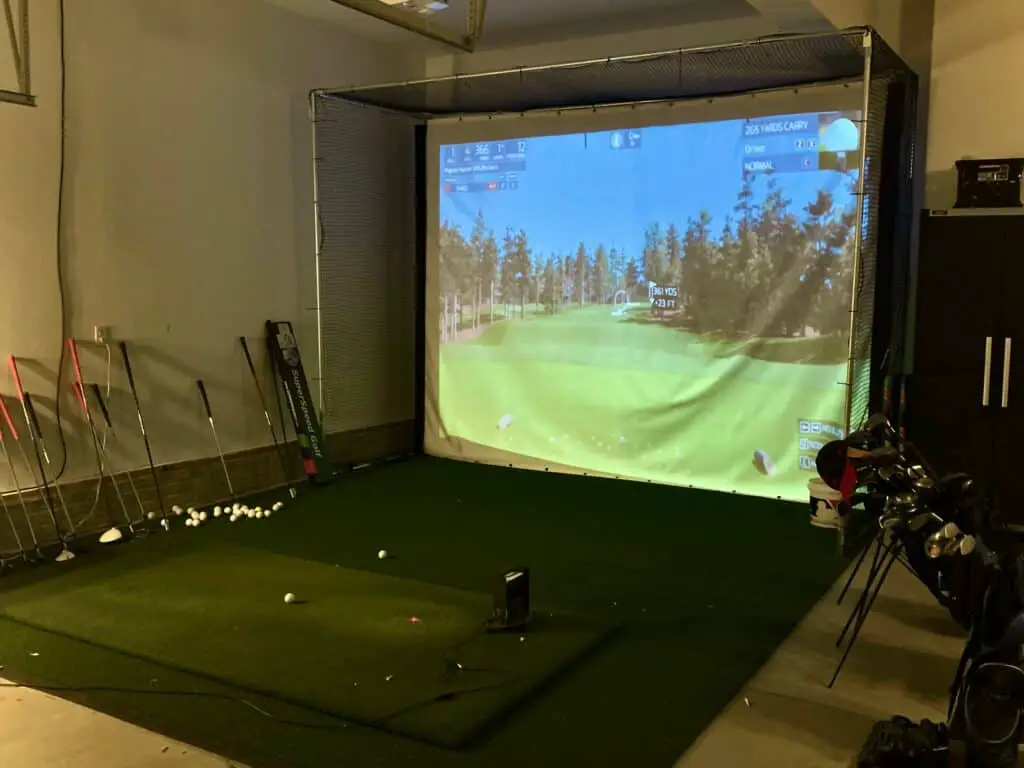It varies! The unique part about the golf swing path is that it varies even amongst the greatest that has ever played. While there is no one perfect swing path there are some elements that are consistent with the best golfers.
With the proper swing path and relative swing path, you can play more consistent golf.
The swing path is the arc that the golf club travels on throughout the swing. The swing path is overall a circular motion where the clubhead moves up and back around the golfer and then down and towards the ball before moving back up and left.
It is often traced using the club head to provide a visual for where the clubhead travels on the backswing and then the downswing.
What Is The Proper Swing Path in Golf?
Key Finding: In studying golfers like Arnold Palmer and Sam Snead you will see that they aim right at address and hit a pull draw at times. Meanwhile, Jack Nicklaus and Lee Trevino aim left at address and hit push fades. They were able to hit their shot when they needed to and relied on different swing paths, but had a great feel for the club face and swing path connection and what shot it produced.
Below I will dive into the elements of the swing path that can help most golfers improve their consistency. At the end of the day, the more consistent your swing path is with the key elements below the more you increase your chances of finding the consistency that all golfers week.
We believe there are 3 key elements to every quality golf swing:
- The golfer is able to control the low point (quality contact).
- The golfer is able to control the start line and curve of the ball (consistency).
- The golfer has enough speed to play the course (distance).
Today’s topic has to do with #2 above. The more the golfer can control the relationship between the swing path and the clubface direction at impact, the better they will be able to hit their start line and control the curve of the ball.
Whether the golfer plays a stock fade or a stock draw, the bottom line is to have a stock shot that you can count on in key times.

Proper Swing Path in Golf: Shallow the swing path
A steep path into the golf ball is a recipe for poor contact and poor start line control. The best golfers are able to shallow the swing path. As the golfer reaches the point in the downswing where their lead arm is parallel to the ground, the club is angled back and towards the inside. This allows the golfer to make crisp contact and maximize distance from the slinging like motion of the club through the hitting zone. Whether the swing path is slightly inside to out or outside to in, the path should be shallow.
Proper Swing Path in Golf: Avoid extreme swing paths
A golfer swing that is excessively inside to out (potential hook or push) or outside to in (potential slice or pull) will struggle with consistency. While the right timing of the clubhead can compensate for these extreme paths, the golfer seeking consistency will want to keep the swing path between 3-5 degrees inside to out or 3-5 degrees outside to in. Many golfers that have played for years have one of these two swings and then occasionally will get too extreme when they struggle the most with the curve of the ball.
Proper Swing Path in Golf: Understand ball flight laws
Did you know that you can get a quality understanding of what your swing did by reading the ball flight after every shot? While we would highly recommend purchasing a launch monitor like the Skytrak or Mevo+, there is a way to read your ball flight and understand what took place through the hitting zone.
Ball Flight Laws: A Basic Overview
- The ball will start in the relative direction of where the clubface is aiming at impact.
- The ball will then curve away from the swing path.
- So if your clubface is left of the swing path at impact, the ball will curve left. If your clubface is right of the swing path at impact, the ball will curve right.
Here is how you can read your ball flight through several examples:
- Shot: Ball starts right and draws left (Push Draw). This is a clubface that is slightly open at impact with a path further to the right.
- Shot: Ball starts right and fades right (Push Fade). This is a clubface that is slightly open at impact with a path that is left of the clubface.
- Shot: Ball starts left and fades right (Pull Fade). This is a clubface that is slightly closed at impact with a path that is left of the clubface.
- Shot: Ball starts left and draws left (Pull Draw). This is a clubface that is slightly closed at impact with a path that is right of the clubface.
Some key items to point out:
- If the curve is extreme, there is a large gap between your clubface and your swing path.
- If the curve is soft, there is a small gap between your clubface and your swing path.
- Arguably the most difficult shot to hit in golf is the straight shot. This requires a perfectly square clubface with a 0 degree path.
Our recommendation is to develop a stock draw or a stock fade that will have a path that is right or left of the clubrace by 1-2 degrees.
Stock Shot Drill
- At the driving range, set up an alignment stick about 6-8 yards in front of you, straight down your target line.
- If you have a second alignment stick, set the stick 3-4 feet right of the first stick (for a draw) or left of the first stick (for a fade).
- Complete your initial assessment see how many times out of 10 you can start the ball to the right or left of your target. Pick one side and measure your game at this point.
- The goal is to eventually get 7 out of 10 shots to start to the correct side and draw back towards the target.
We believe the swing path is only 2nd in importance to the clubface in the golf swing.
Check out this post: What is the most important part of the golf swing?
If you start to struggle with curving the ball too much or being inconsistent with your shot shape, return to this drill and train your clubface and swing path to develop the shot that best fits your game.

Two Common Swing Paths: Inside-Out and Outside-In
The best golfers often play with an inside out swing path. Whether they are hitting a draw or a fade, they will hit the ball from the inside. They will change their alignment to hit a slight push fade if that is the shot that they need. They work their way around the course, living in that slight inside to out swing path zone, controlling the clubface with the hands or the swing path with the feet.
The weakest golfers or those that struggle the most often have an extreme outside to in swing path. As a result, they often fight the push because the swing path can be as much as 8-12 degrees outside to in or across the ball. It is difficult to get the clubface left of that swing path and they continue to swing further left, further causing a larger slice.
One of the best golf instructors to help you finally hit a draw is Shawn Clement. He spends a great deal of time talking about making a natural or athletic motion and using the setup to influence your swing path. Here is our full review of Shawn Clement, here!
Final Thoughts
I would highly recommend using a golf launch monitor to help measure your clubface and your swing path. I purchased a Skytrak Launch Monitor several years ago and the feedback is rather impressive. After every shot, you can receive the following:
- Carry and Total Distance
- Spin Axis
- Spin Rate
- Swing Path
- Launch Angle
- Ball Speed
- Club Speed
In addition, the shot tracer is rather helpful in getting feedback. If you understand the ball flight laws, the shot tracer gives you the immediate feedback about where your clubface was at impact as well as your swing path based on the curve of the ball.
Check Current Price of Skytrak Launch Monitor, Here!

My Secret To Golf Improvement
Let’s face it, in order to get really good at golf, we must practice frequently. About four years ago, I made the leap and invested in a golf simulator build for my garage. I went with a SkyTrak Launch Monitor and the TGC software and can now play over 100,000 courses including Augusta, Pebble Beach, Bethpage Black, Whistling Straits. St. Andrews and many other of the top 100 courses in the world.
This golf simulator setup, which is more affordable that you might imagine, has been a game changer. I can now play golf everyday of the year regardless of rain, snow, cold weather or time of day. I can practice or play rounds of golf. I can stand in the 11th fairway at Augusta and with the auto-rewind feature I am able to practice my approach shots from various differences.
It is worth checking out through Rain or Shine Golf as they offer some incredible packages along with financing offers that are difficult to beat.
Some direct links to Rain or Shine Golf for pricing and financing:
Take Action – What You Can Do Today to Get Better
What does this mean for you? I believe in the following recipe to get better:
1 – Improve your motion in the golf swing by identifying a golf instructor. Here are some options:
Here is a list of golf instructors that we have reviewed:
2 – Train to swing faster and improve your swing speed. Here are some options:
Looking to gain more Speed and Distance in your swing. Two Options:
3 – Understand course strategy and work to break through your next barrier. Here is a series on breaking through:
We have provided guides on how to break 100, 90, 80 and 70. Check out more below, if interested.
4 – Practice Frequently
Did you know that I build a golf simulator in my garage and have played over 500 rounds of golf on my SkyTrak system? It has been a game changer and one worth checking out. Here are some of my other posts on golf simulators frequently asked questions:
- Is a Golf Simulator Worth It?
- How to Build a Golf Simulator?
- What is the Best Golf Simulator?
- Golf Simulator Accessories?
- How to Build a Golf Simulator for under $7000
- Top 11 Reasons to Buy a SkyTrak
- How to Build a Golf Simulator for Under $1000
- Why Build A Golf Simulator?
- What Space is Needed?
- Can A Golf Simulator Improve My Game?
- How Much Does A Golf Simulator Cost?
- Don’t Forget to Check out our 15 best golf swings of all time.
